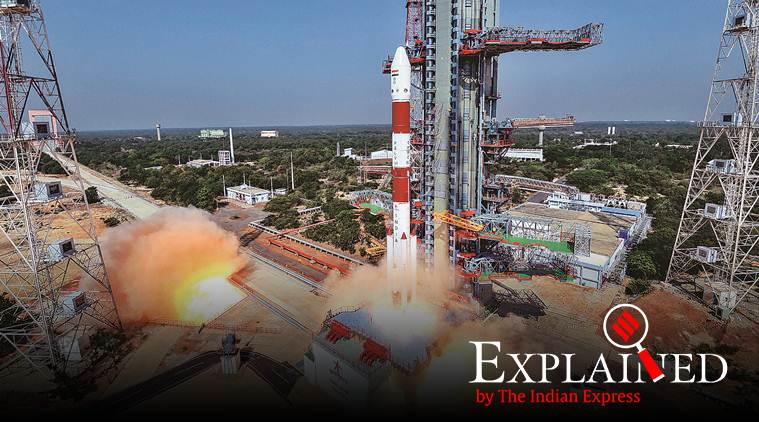Among unique features: satellites placed in 3 different orbits, rocket’s final stage as satellite for some time.

On Monday morning, the Indian Space Research Organisation (ISRO) launched the PSLV-C45 rocket that carried one Indian and 28 international satellites into space. Like many of ISRO’s earlier missions, the launch of PSLV-C45 was special for unique features that were successfully tried out for the first time.
What are these unique features?
Out of several features, at least two stand out. First, it was the first time ISRO launched a rocket that injected satellites in three different orbits. Second, the fourth and last stage of the rocket will function as a satellite itself for some time, instead of being rendered junk after ejecting its payloads. The fourth stage is what remains of the rocket after most of it is discarded — in three stages — during the flight to reduce weight, after running out of the propellant they carry.
Among other firsts, the rocket carried four strap-on motors. Strap-ons are booster rockets attached externally to the main rocket, and provide additional thrust, or energy, by firing themselves midway during the flight. In earlier flights, ISRO has used two or six strap-on motors. The four extra-large strap-ons used this time reduced the overall weight while still delivering the power equivalent to six motors.
Have ISRO rockets not launched multiple satellites into orbit before?
Indeed, ISRO holds the world record for carrying the number of satellites on a single launch vehicle — 104 on PSLV C-37 in February 2017. However, so far, these satellites have been ejected in two different orbits at the most. Three orbits, therefore, is a first.
How was this achieved?
On most previous occasions, the primary satellite was taken to its orbit, while the others were ejected, or sprayed in quick succession either before or after that into different trajectories. There used to be only a marginal difference in the vertical distances between the satellites. The entire operation used to be over in a few minutes.
PSLV C-45 did something very different. It placed the primary satellite, EMISAT, a piece of surveillance equipment to be used by the Defence Research and Development Organisation (DRDO), to the 748 km sun-synchronous polar orbit. It then made one complete revolution around Earth, over the poles, while lowering its orbit to 504 km height, after which it deposited the 28 international customer satellites — 24 from the US, two from Lithuania, and one each from Switzerland and Spain. It then made a further round of Earth while attaining an even lower orbit of 485 km, where the fourth stage of the rocket will continue for some time. This operation took a little over three hours.
For enabling each of the two revolutions around Earth, the fourth-stage engines were reignited, which again was a first. Earlier missions used to be “single-shot” operations in which the engines used to fire just once.
What is the significance of the achievement?
Reaching three different orbits gives ISRO a new technological edge. It demonstrated its capability to reuse the fourth-stage engines multiple times, and also showed that the guidance and navigation systems aboard the launch vehicle could be used for much longer times than in earlier missions.
In practical terms, it will help ISRO pack its future rockets with multiple satellites even if they require to be placed in very diverse but precise orbits. Currently, this could be done only in multiple missions.
And what is the significance of using the fourth stage as a satellite?
The rocket, or the launch vehicle, is only a carrier. Once it places its passenger, or satellite, to its designated orbit in space, it becomes practically useless, adding to the space debris. For the last few years, ISRO had been planning to give some life to the rocket — at least to the uppermost part, or the last stage — which remains with the satellite till the ejection. The lower parts of the rocket are in any case discarded in the earlier stages and become junk. There is no way to put them to any use. The uppermost stage, however, can be used, at least temporarily. Previously, they would end up in some orbit to wander aimlessly and endlessly.
What purpose will it serve?
The fourth stage is carrying three kinds of equipment to carry out some measurements and experiments, and a solar panel to provide power to these equipments and enable communication with ground stations. One kind of instrument can be used to capture messages transmitted from ships, another can be used by amateur radio operators use for tracking and monitoring position data, and the third can study the structure and composition of the ionosphere.
How long will it function?
The fourth stage will not have the usual life of a satellite. It can remain alive only for a few weeks or a few months, since it is not equipped with a lot of other things that enable a satellite to exist for longer duration in outer space, like a radiation shield. However, this is still good enough time to carry out shorter duration experiments and data collection, like the three on-board instruments are meant to do.
In future, such an “orbital platform”, as it is being described, can also be used to inject smaller satellites into orbits.
